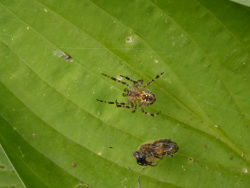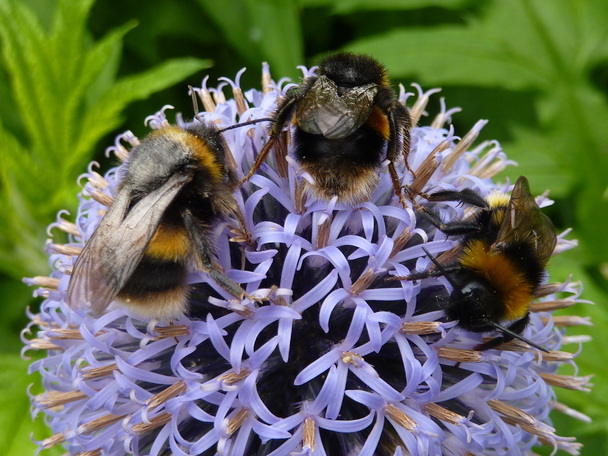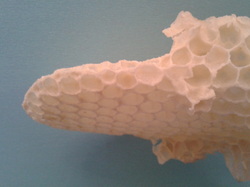Kenwood Apiary
A few weeks ago I killed a wax moth larva on the frame of my Hive 1. I have been keeping a careful watch on the frames since then. Unfortunately last thursday some of the other bee-keepers discovered a nucleus hive and two apidea, with new queens, were infested with wax moth grubs and the wax cells destroyed. The nucleus was I think saved but the new apidea colonies were thought to be 'beyond repair'. There will need to be some review of hygiene practices regarding cleaning the polystyrene apidea. There is a rigorous scorching of wooden frames after use and careful storage of drawn wax frames to be re-used. It may just be very bad luck.
Two years ago I had a colony of bumble bees which despite an entrance escape trap for the bees, had the nest infiltrated and destroyed by wax moth. The brood box was full of web and inch long grubs crawling around - disgusting. I was very upset and did a lot of research on wax moth prevention and treatment. Bumblebees are more susceptible to be wiped out by wax moth than honeybees. The moths like the old frames with traces of wax and can over-winter in cracks, although a treatment is to put frames to be re-used in the deep freeze for 48 hours. There is also a proprietary treatment which is a biological control that the frames can be treated with as obviously you cannot scorch drawn frame with comb that you want to use as a basis for the next honey season. I shall have to think carefully how I am going to clean and store my first season super frames at home. I rather favour the freezer if the frames will fit and I can make room in there. Followed by sealing the frames into a plastic box - having made sure that the frame is dry, or mould will be the next problem.
Garden Hive
The bees have been very busy foraging this week. At the last inspection I swapped the unfilled and capped super frames in Super 1 to the centre and these are now full and capped. Super 2 is also full and mostly capped and super 3 is filling. I re-made the problem super and after much reading and debate decided to add it today. I cannot borrow the Association honey extractor as it is booked out and cannot buy one as they are temporarily sold out. My plan is to buy a big plastic box with a lid and put the full frames in here until they can be extracted. i will then re-arrange the frames in the hive probably reducing the number of supers. The honey flow is coming to an end and I do not want to over-super and end up with loads of half-filled frames that cannot be harvested as the water content is too high and the honey would ferment. I also need enough honey for the bees to over winter. I noticed that there is still plenty of brood in the brood box but the bees are also beginning to add stores to the new brood frames I added which is good news.
The less good news this week was that the builders working on the roof next door found a wasp nest and a day after treatment my neighbour mentioned that they had been spraying poison powder all around the nest and the kitchen extension roof. When I asked about what had been used, the contra-indicators and if the entrance had been blocked there was little concern that dying wasps carrying poison might also fly to the hive on a robbing mission and poison some of my bees - not to mention add poison into the honey. A slight risk you might say but I was disappointed that I had not been consulted, or informed at the time.
Today, doing my weekly inspection Tony spotted a 'bee fight' outside the hive. I pointed out that it was in fact a bee and a wasp fighting. The wasp on a robbing mission and the bee defending the hive. There were several wasps around. I had made a wasp trap yesterday - no fatalities yet. I will reduce the hive entrance with the entrance block making it easier for the bees to guard and repel invaders. There were no wasps within the hive and the colony is large and lively. As I had just re-built the hive and added a 4th super I couldn't insert the block and decided that dismantling again was a bit too much of a disturbance. Also it is going to be a hot week so the ventilation is probably good. Although I know some experienced beekeepers advocate keeping the block in all year round arguing that the mesh floors provide adequate ventilation. Close monitoring required.
Inside the hive there were no signs of queen cups, having shaken bees off each frame and of course no sign of the elusive queen but I had my queen catcher and marker pen ready if I had seen her. Plenty of larvae and a purposefully active colony, so I hopefully all is well. I moved the least used old, short, brood frame to the outside of the brood box with one of the new un-drawn long frames next to it - hopefully the few larvae will hatch, her majesty will not visit and I can get rid of the horrid old thing and reduce my own chances of getting wax-moth in my hive.
During the coming week I need to prepare everything for honey extraction which is going to be a right messy job ........................
A few weeks ago I killed a wax moth larva on the frame of my Hive 1. I have been keeping a careful watch on the frames since then. Unfortunately last thursday some of the other bee-keepers discovered a nucleus hive and two apidea, with new queens, were infested with wax moth grubs and the wax cells destroyed. The nucleus was I think saved but the new apidea colonies were thought to be 'beyond repair'. There will need to be some review of hygiene practices regarding cleaning the polystyrene apidea. There is a rigorous scorching of wooden frames after use and careful storage of drawn wax frames to be re-used. It may just be very bad luck.
Two years ago I had a colony of bumble bees which despite an entrance escape trap for the bees, had the nest infiltrated and destroyed by wax moth. The brood box was full of web and inch long grubs crawling around - disgusting. I was very upset and did a lot of research on wax moth prevention and treatment. Bumblebees are more susceptible to be wiped out by wax moth than honeybees. The moths like the old frames with traces of wax and can over-winter in cracks, although a treatment is to put frames to be re-used in the deep freeze for 48 hours. There is also a proprietary treatment which is a biological control that the frames can be treated with as obviously you cannot scorch drawn frame with comb that you want to use as a basis for the next honey season. I shall have to think carefully how I am going to clean and store my first season super frames at home. I rather favour the freezer if the frames will fit and I can make room in there. Followed by sealing the frames into a plastic box - having made sure that the frame is dry, or mould will be the next problem.
Garden Hive
The bees have been very busy foraging this week. At the last inspection I swapped the unfilled and capped super frames in Super 1 to the centre and these are now full and capped. Super 2 is also full and mostly capped and super 3 is filling. I re-made the problem super and after much reading and debate decided to add it today. I cannot borrow the Association honey extractor as it is booked out and cannot buy one as they are temporarily sold out. My plan is to buy a big plastic box with a lid and put the full frames in here until they can be extracted. i will then re-arrange the frames in the hive probably reducing the number of supers. The honey flow is coming to an end and I do not want to over-super and end up with loads of half-filled frames that cannot be harvested as the water content is too high and the honey would ferment. I also need enough honey for the bees to over winter. I noticed that there is still plenty of brood in the brood box but the bees are also beginning to add stores to the new brood frames I added which is good news.
The less good news this week was that the builders working on the roof next door found a wasp nest and a day after treatment my neighbour mentioned that they had been spraying poison powder all around the nest and the kitchen extension roof. When I asked about what had been used, the contra-indicators and if the entrance had been blocked there was little concern that dying wasps carrying poison might also fly to the hive on a robbing mission and poison some of my bees - not to mention add poison into the honey. A slight risk you might say but I was disappointed that I had not been consulted, or informed at the time.
Today, doing my weekly inspection Tony spotted a 'bee fight' outside the hive. I pointed out that it was in fact a bee and a wasp fighting. The wasp on a robbing mission and the bee defending the hive. There were several wasps around. I had made a wasp trap yesterday - no fatalities yet. I will reduce the hive entrance with the entrance block making it easier for the bees to guard and repel invaders. There were no wasps within the hive and the colony is large and lively. As I had just re-built the hive and added a 4th super I couldn't insert the block and decided that dismantling again was a bit too much of a disturbance. Also it is going to be a hot week so the ventilation is probably good. Although I know some experienced beekeepers advocate keeping the block in all year round arguing that the mesh floors provide adequate ventilation. Close monitoring required.
Inside the hive there were no signs of queen cups, having shaken bees off each frame and of course no sign of the elusive queen but I had my queen catcher and marker pen ready if I had seen her. Plenty of larvae and a purposefully active colony, so I hopefully all is well. I moved the least used old, short, brood frame to the outside of the brood box with one of the new un-drawn long frames next to it - hopefully the few larvae will hatch, her majesty will not visit and I can get rid of the horrid old thing and reduce my own chances of getting wax-moth in my hive.
During the coming week I need to prepare everything for honey extraction which is going to be a right messy job ........................



 RSS Feed
RSS Feed
